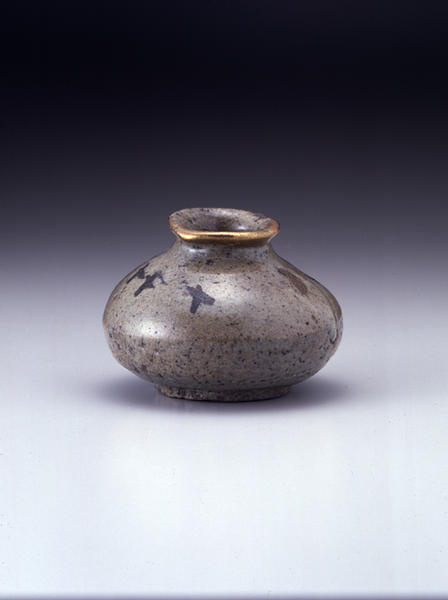絵唐津鳥文振出
- 佐賀県・唐津窯
- 桃山~江戸時代
- 17c
- 施釉陶製
- H-7 D-9
- 所蔵
- 倉橋廣次郎旧蔵
解説(春の玉手箱)
唐津焼は天正年間(一五七三~一五九二)にその起源を持つといい、文禄・慶長の役に伴い渡来した朝鮮陶工により多くの窯が開かれた。食器や茶道具が多く作られ、古い時代のものほど素朴で、自由奔放な作風や絵付が魅力である。この振出は絵唐津の小壺を見立てたもので、金平糖や麦焦などを入れて茶事の折、寄付や待合の汲出盆に具えておくのに使用する。
胴部には数羽の鳥たちがごく省略した筆致で描かれる。夕暮れに帰山する烏の群れであろうか、鳥と柔らかな焼肌とが郷愁を誘う空間を生んでいる。窯内の高温で口縁や胴部がわずかに揺らぎ、この小さな壺の愛らしさを一層引き立てている。
Catalogue Entry
Karatsu ware was established in the Tensho era (1573‐1592) and a large number of kilns were opened in the area by the Koreans potters who were brought to Japan after Hideyoshi's invention of Korea during the Bunroku and Keicho eras. The kilns produced large numbers of household dishes and utensils for the tea ceremony, and while the older examples are simpler, all characterized by a fascinatingly free style and charming painted decoration. This furidashi pot is a miniature imitation of a small Karatsu jar, and would have been used during a tea ceremony event to contain either sweets or parched barley flour. Such a container would have been placed on a tray with other small items in the waiting area for guests about to enter a tea ceremony, or to enjoy during intervals in the ceremony. The torso of this jar is decorated with extremely abbreviated renderings of several birds. Possibly a flock of crows returning to the mountains at sunset, the birds and the gentle fired texture of the ceramic seem to evoke an invitation to a welcoming home. The rim and a section of the torso were warped in the heat of the kiln, but that slight quaver in shape only heightens the attractive quality of this little pot.
